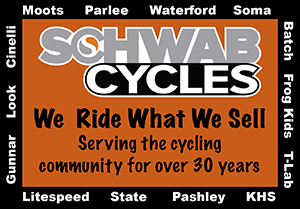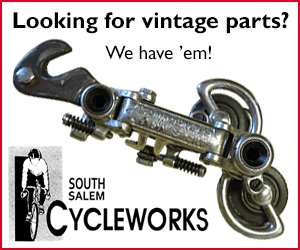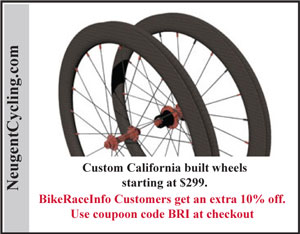

The Long Story Behind the Bankruptcies of Performance & Nashbar
Part 1: The Economics of the Bike Industry
by John Neugent
Tech articles | Commentary articles
Performance & Nashbar Bankruptcies Stories: Part 2 | Part 3
John Neugent probably knows more about bicycle wheels than anyone else alive. Maybe more about bikes as well. He's spent his life in the bike business, at every level. He now owns Neugent Cycling, a firm devoted to delivering world-class equipment at the lowest possible price. If you are in the market for a set of wheels, please, check out John's site. He really knows his stuff. —Chairman Bill

John Neugent

James Witherell's book Bicycle History: A Chronological History of People, Races and Technology is available in both print and Kindle eBook formats. To get your copy just click on the Amazon link on the right.
John Neugent writes:
Two powerhouse retailers in the cycling industry went bankrupt. They were not only powerhouses, they were disruptors who helped redefine retail. In the '80s they were often at the tip of tongue of most retailers, and not in a good way. This is the first of a multipart series looking at how they came to fame, grew, and died. It’s a story of the industry as a whole, and the story is far from over.
The first part some may feel is a little wonkish, a term Paul Krugman—the Nobel winning economist writing for the New York Times—often uses, but this deals with the economics of the industry and to understand what has happened, it’s a key part of the story. It will also help you to understand, but not predict, the future.
These are the numbers that will help you understand how the pieces fit together. The numbers are approximations and are based on my experience in the industry. I assume most other industries are similar. Also understand, they are opaque because everyone accounts for things differently (is freight included in the cost of goods and therefore marked up?). Nevertheless, they give you a window into the financial mechanics of the industry.
The big OEM (original equipment manufacturer – they make the bulk of the parts on bikes) brands like Shimano and Sram sell to OEM customers (Trek, Giant, Merida) with about a 40-50% profit margin. If they sell a part for $1 it costs them 50–60 cents to make. They sell the same part, sometimes to the same customer, in aftermarket form (in boxes instead of bulk) for 10–30% more. Always realize there are price lists and then negotiated prices, sometimes based on reduced cost (the Giant and Shimano computers are linked for efficiency) and sometimes not. So, in many ways, there is an uneven playing field, which I believe is fair, and whether I like it or not, it’s the way humans do business.
Distributors of aftermarket items (not sold as an OEM part on a bike, or as an accessory) generally work on 30–40% margins for items other than bikes. The margins vary widely but that’s a good average, but their cost is also generally higher than a big OEM customer like Trek or Specialized.
Retailers work on about 50% margins on non-bike items and 30–40% on complete bikes, with 40% being pretty much a holy grail almost never really realized (especially when you consider closeouts). Numerous studies have shown the retailer's cost of doing business is about 40%, but in fairness, that cost of doing business included the owner’s salary.
The point of this is to show that, while we believe prices are largely based on the cost of manufacturing something, it’s the cost of the distribution channel that determines the retail price. Something that cost $1 to make can easily sell for $5–15, with the bulk of the costs being all of the middlemen. Adding to this complexity are the differences in the global markets, where traditions still mostly rule.
Looking at this from the outside, it’s easy to see ways to eliminate cost by simply eliminating layers of distribution. But in reality, it’s much more difficult, because there are lifelong relationships built up between vendors and customers. In the next article, I will go into these in more depth. One of the huge changes that rocked the industry happened during the bike boom of the late '60s and early '70s that had a major brand deciding to eliminate their distributors. That, and the introduction and success of the 10-speed road bike, set off a series of events. For the first time, adults were in love with bikes in a big way.
John Neugent was was one of the first to establish quality hand building in Taiwan around the turn of the century. He now owns Neugent Cycling, a firm devoted to delivering world-class equipment at the lowest possible price.
.








